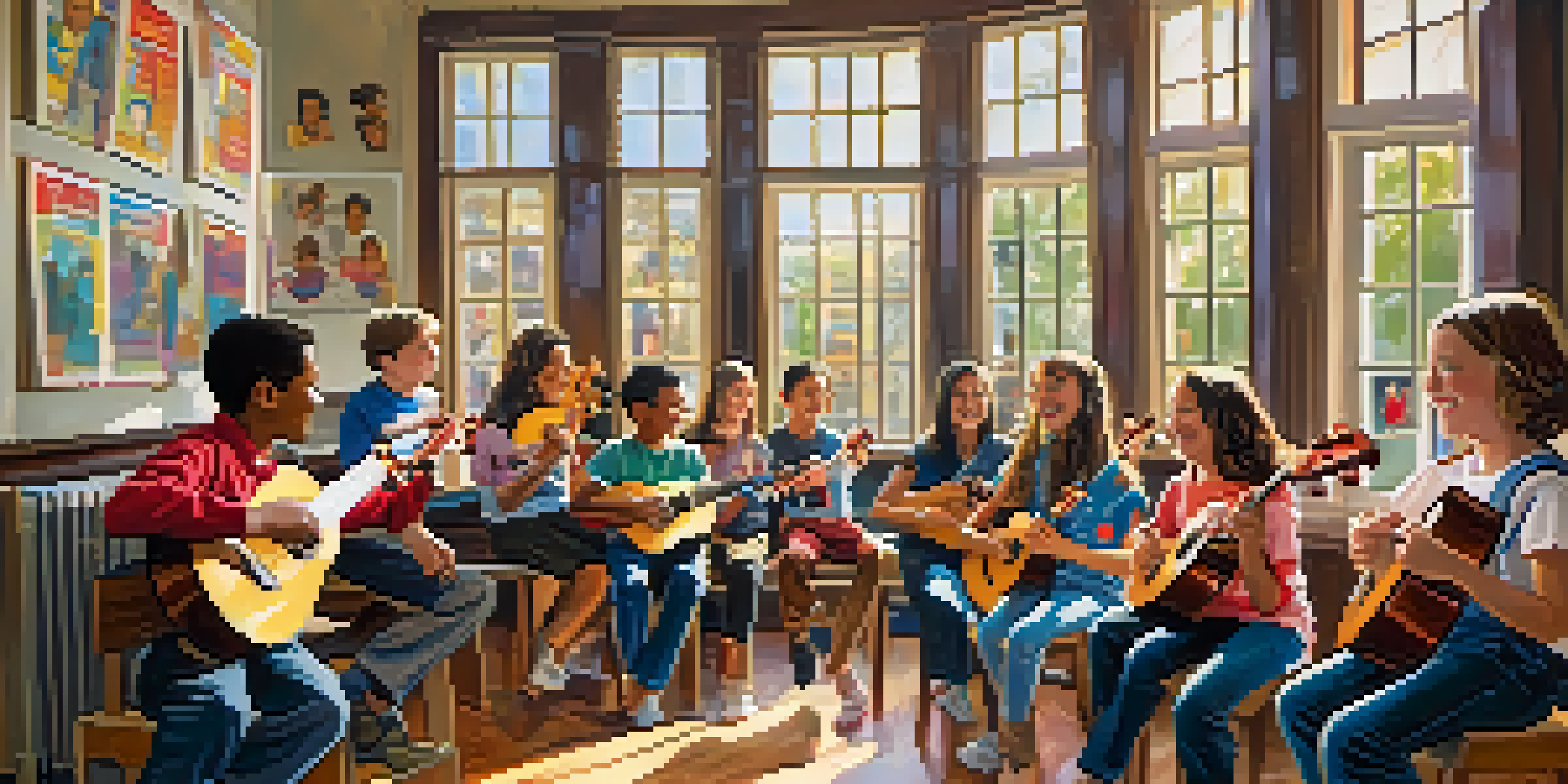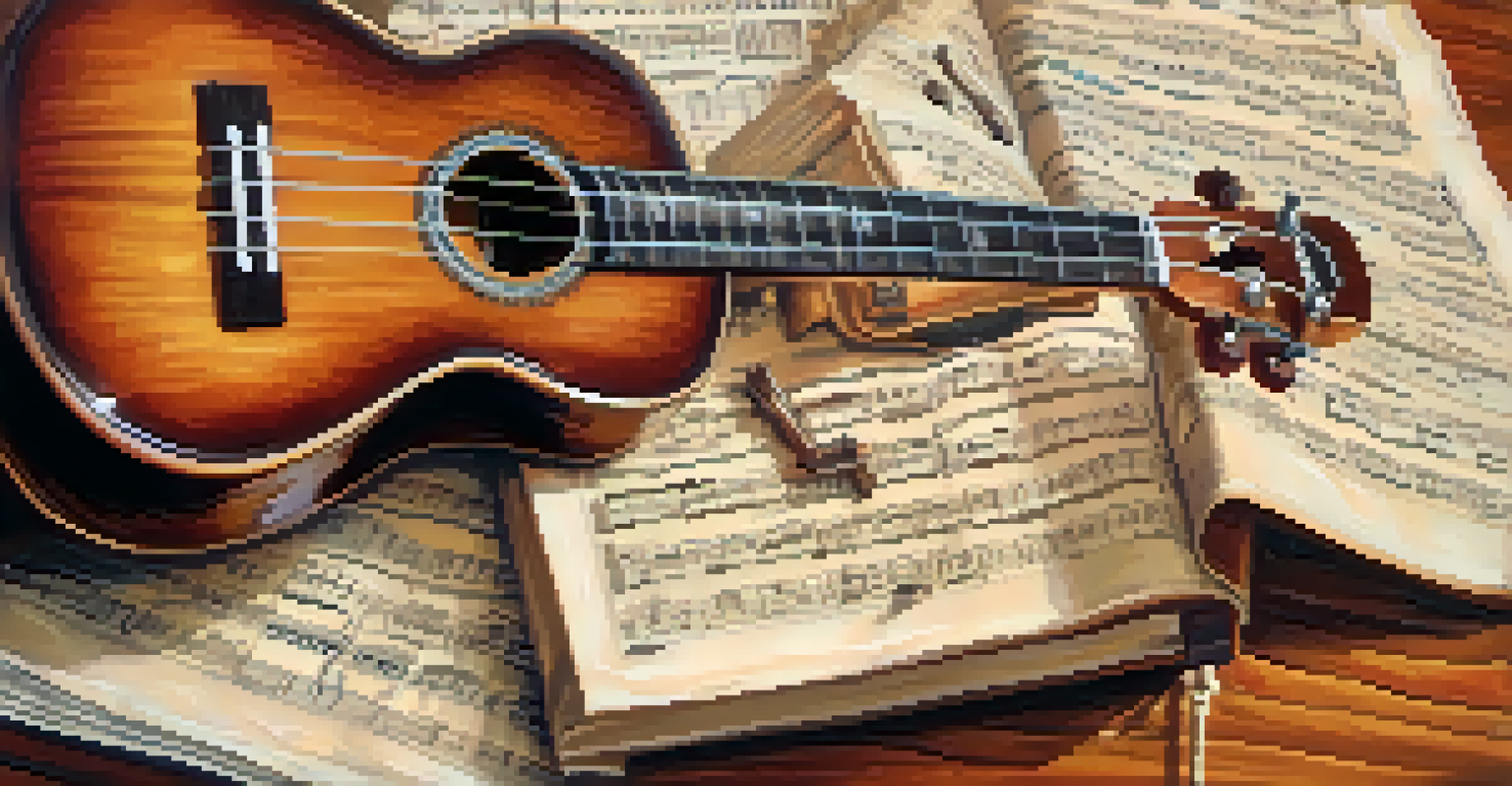Creating a Ukulele Curriculum for Middle School Music

Understanding the Benefits of Teaching Ukulele
The ukulele is a fantastic instrument for middle school students, offering a fun and approachable way to engage with music. Its small size and light weight make it perfect for young learners, allowing them to handle it easily and feel comfortable while playing. Moreover, the ukulele's cheerful sound can inspire creativity and joy, making music lessons more enjoyable.
Music can change the world because it can change people.
In addition to its accessibility, learning the ukulele helps develop essential musical skills such as rhythm, melody, and harmony. Students can quickly grasp basic chords and strumming patterns, which boosts their confidence and encourages them to play along with their favorite songs. This immediate sense of achievement can be particularly motivating for middle schoolers who are often seeking validation.
Furthermore, the ukulele fosters a sense of community and collaboration among students. Group activities, like ensemble playing or songwriting, not only enhance their teamwork skills but also lead to lasting friendships. Ultimately, incorporating the ukulele into your curriculum can create a vibrant and supportive musical environment.
Setting Clear Learning Objectives for Students
Establishing clear learning objectives is crucial for any music curriculum, and the ukulele is no exception. Start by outlining what you want your students to achieve by the end of the course, such as mastering basic chords, playing simple songs, and understanding music theory concepts. These objectives will serve as a roadmap, guiding both you and your students throughout the learning process.

It's also important to tailor these objectives to the unique needs and interests of your students. For example, some may be more inclined towards strumming techniques, while others might be interested in fingerpicking or songwriting. By personalizing your objectives, you can ensure that every student feels engaged and motivated to progress.
Benefits of Learning Ukulele
The ukulele offers an enjoyable way for middle school students to engage with music while developing essential skills.
Lastly, don't forget to incorporate both formative and summative assessments to measure student progress. Regular check-ins, such as informal performances or quizzes, can help you gauge their understanding and provide constructive feedback. This approach not only keeps students accountable but also helps them celebrate their achievements along the way.
Choosing the Right Ukulele for Your Classroom
Selecting the right ukulele for your classroom is essential for fostering a positive learning experience. Consider factors such as size, quality, and budget when making your choice. Soprano ukuleles are the most common for beginners, but concert or tenor sizes might suit older students better due to their larger fretboards and fuller sound.
The beautiful thing about learning is that no one can take it away from you.
Quality matters, especially in a classroom setting where instruments will be handled by many students. Look for ukuleles made from durable materials that can withstand the wear and tear of daily use. Brands that offer good sound quality and playability without breaking the bank can help you create a reliable ukulele inventory.
Finally, consider the importance of having enough ukuleles for all your students. If budget constraints limit your options, think about partnering with local music shops or community organizations to secure rental instruments or sponsorships. Ensuring each student has access to a ukulele will promote inclusivity and enhance their learning experience.
Creating a Structured Lesson Plan
A well-structured lesson plan is the backbone of any successful music curriculum, including ukulele classes. Begin each lesson with clear objectives, followed by engaging activities that promote active learning. For instance, you might start with a warm-up exercise, then introduce a new chord, and finish with a group performance of a popular song.
Incorporating a variety of teaching methods can cater to different learning styles among your students. Consider using visual aids, interactive games, and hands-on activities to keep students engaged and motivated. For example, using chord charts, videos, or even apps can help students grasp concepts more effectively.
Importance of Clear Objectives
Setting clear learning objectives helps guide students through their ukulele education, ensuring personalized engagement.
Lastly, allocate time for reflection and review at the end of each lesson. Encourage students to share their thoughts on what they learned, what they enjoyed, and any challenges they faced. This feedback can help you adjust future lessons and ensure a continuous improvement in your teaching approach.
Incorporating Music Theory into Ukulele Lessons
Integrating music theory into your ukulele lessons is essential for developing well-rounded musicians. Start with the basics, such as understanding notes, rhythms, and scales, and gradually introduce more complex concepts like chord progressions and key signatures. By connecting these theoretical elements to practical playing, students can appreciate the underlying structure of the music they love.
Using relatable examples can make abstract concepts easier to understand. For instance, you might explain the circle of fifths using familiar songs that students can recognize. By showing how theory relates to their favorite music, you can spark their interest and make the learning process enjoyable.
Additionally, consider incorporating songwriting exercises that encourage students to apply their theoretical knowledge creatively. This hands-on approach not only reinforces their understanding of music theory but also cultivates their unique musical voices. Engaging students in this way can lead to a deeper appreciation for music and inspire them to explore their creativity further.
Encouraging Student Collaboration and Performance
Encouraging collaboration among students is vital for building a sense of community and enhancing their learning experience. Organize group activities such as jam sessions, where students can play together, share ideas, and learn from one another. This not only fosters teamwork but also helps students develop their listening skills and adaptability.
Performance opportunities are another great way to motivate students and build their confidence. Consider hosting informal showcases or talent shows where students can share what they've learned with their peers or family members. These events can create a supportive atmosphere that promotes a shared love for music and encourages students to take pride in their accomplishments.
Evaluating Your Curriculum
Regular evaluation and adaptation of your curriculum is essential for meeting students' needs and keeping the learning experience relevant.
Finally, encourage students to collaborate on songwriting projects or create arrangements of their favorite songs. This not only provides a platform for creativity but also allows them to practice essential skills like communication and compromise. By working together, students can strengthen their relationships and create lasting memories.
Evaluating and Adapting Your Curriculum
Evaluating your ukulele curriculum regularly is crucial for ensuring its effectiveness and relevance. Gather feedback from students and assess their progress to identify areas that may need improvement. This ongoing evaluation can help you stay in tune with your students' needs and interests, ultimately enhancing their learning experience.
Don't hesitate to adapt your curriculum based on this feedback. If you notice that certain topics are challenging for students or that they express interest in specific genres or skills, be flexible in your approach. Adjusting your lesson plans to accommodate their preferences can lead to a more engaging and enjoyable learning environment.

Finally, stay informed about new teaching methods, resources, and trends in music education. Attend workshops, join online forums, or read relevant literature to keep your knowledge fresh. By continuously evolving your curriculum, you can ensure that your ukulele program remains engaging and effective for your middle school students.